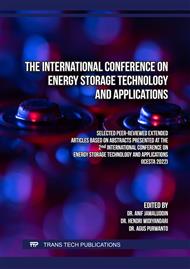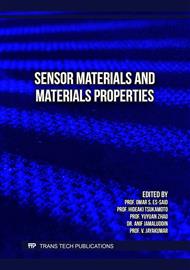[1]
S. W. Lee et al., High-power lithium batteries from functionalized carbon-nanotube electrodes, Nat. Nanotechnol. 5 (2010) 531–537.
Google Scholar
[2]
D. Sui et al., High performance Li-ion capacitor fabricated with dual graphene-based materials, Nanotechnology, 32 (2021).
Google Scholar
[3]
Z. Wei, H., Wang, H., Li, A., Li, H., Cui, D., Dong, M., ... & Guo, Advanced porous hierarchical activated carbon derived from agricultural wastes toward high performance supercapacitors, J. Alloys Compd. 820 (2020) 1-26.
DOI: 10.1016/j.jallcom.2019.153111
Google Scholar
[4]
X. Song, X. Ma, Y. Li, L. Ding, and R. Jiang, Tea waste derived microporous active carbon with enhanced double-layer supercapacitor behaviors, Appl. Surf. Sci. 487 (2019) 189–197.
DOI: 10.1016/j.apsusc.2019.04.277
Google Scholar
[5]
S. Sundari Gunasekaran, R. Subashchandra Bose, and K. Raman, Electrochemical Capacitive Performance of ZnCl2 Activated Carbon Derived from Bamboo Bagasse in Aqueous and Organic Electrolyte, Orient. J. Chem. 35 (2019) 302–307.
DOI: 10.13005/ojc/350136
Google Scholar
[6]
E. Taer, N. Yanti, W. S. Mustika, A. Apriwandi, R. Taslim, and A. Agustino, Porous activated carbon monolith with nanosheet/nanofiber structure derived from the green stem of cassava for supercapacitor application, Int. J. Energy Res. 44 (2020) 10192–10205.
DOI: 10.1002/er.5639
Google Scholar
[7]
D. Kasprzak and M. Galinski, Chitin as a Universal and Sustainable Electrode Binder for Electrochemical Capacitors, SSRN Electron. J. (2022) 1–37.
DOI: 10.2139/ssrn.4165529
Google Scholar
[8]
G. Phachwisoot et al., Sequential Production of Levulinic Acid and Supercapacitor Electrode Materials from Cassava Rhizome through an Integrated Biorefinery Process, ACS Sustain. Chem. Eng. 9 (2021) 7824–7836.
DOI: 10.1021/acssuschemeng.1c01335
Google Scholar
[9]
J. Ospino-Orozco, J. Parra-Barraza, S. Cervera-Cahuana, E. E. Coral-Escobar, and O. Vargas-Ceballos, Activated carbon from cassava peel: A promising electrode material for supercapacitors, Rev. Fac. Ing. Univ. Antioquia. 102 (2022) 88–95.
DOI: 10.17533/udea.redin.20200803
Google Scholar
[10]
S. Chaisit, N. Chanlek, J. Khajonrit, T. Sichumsaeng, and S. Maensiri, Preparation, characterization, and electrochemical properties of KOH-activated carbon from cassava root, Mater. Res. Express. 7 (2020).
DOI: 10.1088/2053-1591/abbf84
Google Scholar
[11]
O. Sathish-Kumar, K., Vázquez-Huerta, G., Rodríguez-Castellanos, A., Poggi-Varaldo, H. M., & Solorza-Feria, Microwave assisted synthesis and characterizations of decorated activated carbon, Int. J. Electrochem. Sci. 7 (2012) 5484–5494.
DOI: 10.1016/s1452-3981(23)19636-2
Google Scholar
[12]
Y. Liu et al., Accommodation of Silicon in an Interconnected Copper Network for Robust Li‐Ion Storage, Adv. Funct. Mater. 30 (2020) 191–249.
Google Scholar
[13]
A. Daulay, Andriayani, Marpongahtun, and S. Gea, Synthesis Si nanoparticles from rice husk as material active electrode on secondary cell battery with X-Ray diffraction analysis, South African J. Chem. Eng. 42 (2022) 32–41.
DOI: 10.1016/j.sajce.2022.07.004
Google Scholar
[14]
Y.-J. Heo and S.-J. Park, Synthesis of activated carbon derived from rice husks for improving hydrogen storage capacity, J. Ind. Eng. Chem. 31 (2015) 330–334.
DOI: 10.1016/j.jiec.2015.07.006
Google Scholar
[15]
S. Mopoung, S., Moonsri, P., Palas, W., & Khumpai, Characterization and properties of activated carbon prepared from tamarind seeds by KOH activation for Fe (III) adsorption from aqueous solution, Sci. world J. (2015) 1-9.
DOI: 10.1155/2015/415961
Google Scholar
[16]
G. H. Lim, J.-W. Lee, J.-H. Choi, Y. C. Kang, and K. C. Roh, Efficient utilization of lignin residue for activated carbon in supercapacitor applications, Mater. Chem. Phys. 284 (2022).
DOI: 10.1016/j.matchemphys.2022.126073
Google Scholar
[17]
A. Gupta, A. Jain, and S. K. Tripathi, Structural, electrical and electrochemical studies of ionic liquid-based polymer gel electrolyte using magnesium salt for supercapacitor application, J. Polym. Res. 28 (2021) 235.
DOI: 10.1007/s10965-021-02597-9
Google Scholar
[18]
Y. Zhao et al., Fluorinated ether electrolyte with controlled solvation structure for high voltage lithium metal batteries, Nat. Commun. 13 (2022).
DOI: 10.1038/s41467-022-29199-3
Google Scholar
[19]
B. Fang et al., Fabrication of hollow core carbon spheres with hierarchical nanoarchitecture for ultrahigh electrical charge storage," J. Mater. Chem. 22 (2012) 19-31.
DOI: 10.1039/c2jm33435f
Google Scholar
[20]
G. Nagaraju, S. C. Sekhar, B. Ramulu, S. K. Hussain, D. Narsimulu, and J. S. Yu, Ternary MOF-Based Redox Active Sites Enabled 3D-on-2D Nanoarchitectured Battery-Type Electrodes for High-Energy-Density Supercapatteries, Nano-Micro Lett. 13 (2021) 17.
DOI: 10.1007/s40820-020-00528-9
Google Scholar
[21]
Z. Zapata-Benabithe, F. Carrasco-Marín, and C. Moreno-Castilla, "Electrochemical performance of Cu- and Ag-doped carbon aerogels, Mater. Chem. Phys. 138 (2013)870-876.
DOI: 10.1016/j.matchemphys.2012.12.076
Google Scholar
[22]
S. J. Yang, G., & Park, Nanoflower-like NiCo2O4 grown on biomass carbon coated nickel foam for asymmetric supercapacitor, J. Alloys Compd. 835 (2020) 155–270.
DOI: 10.1016/j.jallcom.2020.155270
Google Scholar
[23]
S. Azmi, A. Klimek, and E. Frackowiak, Anticorrosive performance of green deep eutectic solvent for electrochemical capacitor, Chem. Eng. J. 444 (2022).
DOI: 10.1016/j.cej.2022.136594
Google Scholar
[24]
B. Pal, S. Yang, S. Ramesh, V. Thangadurai, and R. Jose, Electrolyte selection for supercapacitive devices: a critical review, Nanoscale Adv. 1 (2019) 3807–3835.
DOI: 10.1039/c9na00374f
Google Scholar
[25]
T. Nguyen and M. de F. Montemor, Metal Oxide and Hydroxide–Based Aqueous Supercapacitors: From Charge Storage Mechanisms and Functional Electrode Engineering to Need‐Tailored Devices, Adv. Sci. 6 (2019).
DOI: 10.1002/advs.201801797
Google Scholar



